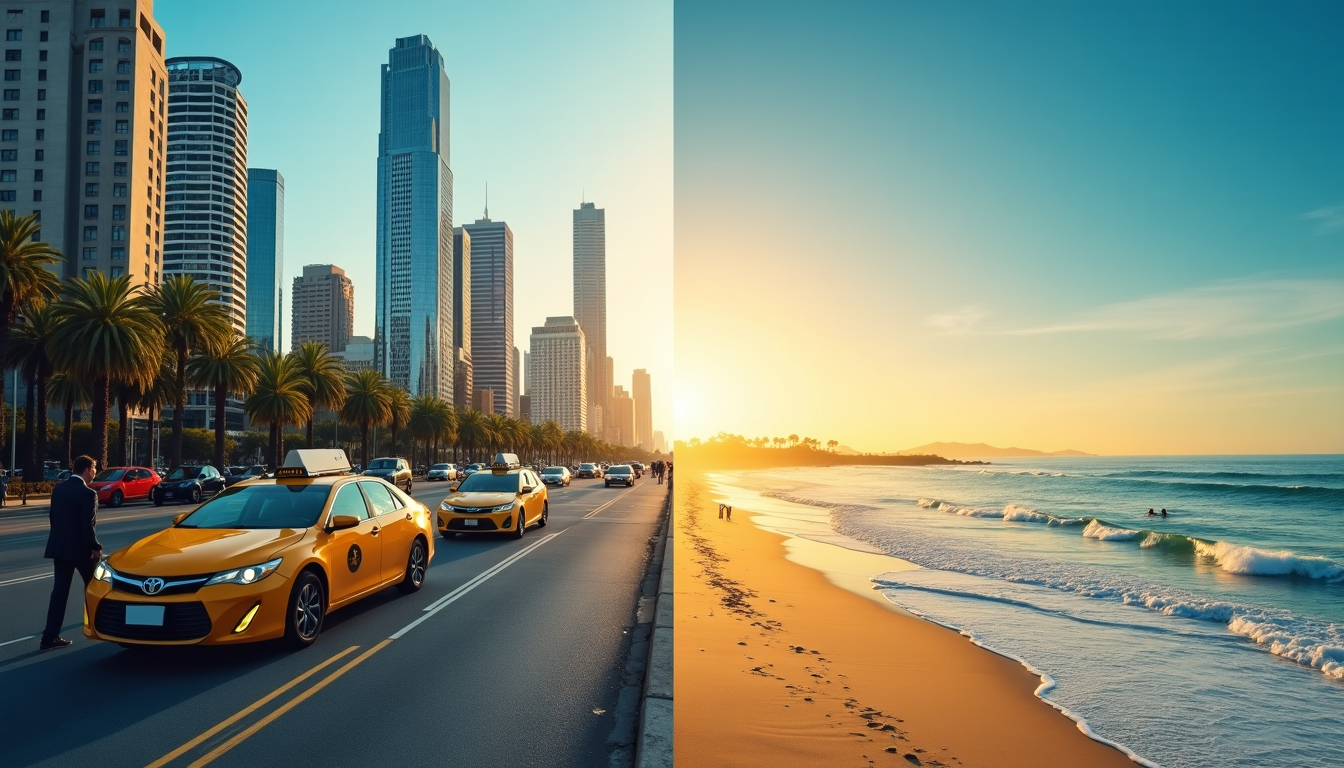East Coast vs West Coast: Which Coast Is Right for You?
The debate between East Coast vs West Coast living has long captivated Americans and visitors alike.


The debate between East Coast vs West Coast living has long captivated Americans and visitors alike. Both regions offer unique experiences, each with its own distinct charm and challenges. From weather patterns to cultural nuances, the differences between these two coasts shape daily life in significant ways. Understanding these contrasts can help individuals make informed decisions about where to live, work, or visit.
This article explores the key factors that set the East and West Coasts apart. It examines geographic and climate distinctions, delves into cultural and social dynamics, and compares economic landscapes and living costs. Additionally, it highlights the lifestyle and recreational opportunities each coast provides. By the end, readers will have a clearer picture of what each coast has to offer, helping them determine which might be the better fit for their preferences and needs.
Geographic and Climate Distinctions
The East Coast and West Coast of the United States present distinct geographic features and climate patterns that significantly influence daily life and activities. These differences stem from various factors, including coastal landscapes, weather systems, and seasonal changes.
Coastal landscapes and natural features
The East Coast boasts a diverse range of landscapes, from the Appalachian Mountains to the coastal plains. Its shoreline is characterized by a large continental shelf, creating expansive beaches and shallow waters. In contrast, the West Coast has a more dramatic topography, with steep cliffs and a deep offshore trench. The Pacific coastline is rugged and varied, featuring cliffs, beaches, and coastal forests. This sharp difference in terrain has a profound impact on the coastal environment and the activities available to residents and visitors.
Weather patterns and seasonal changes
The weather on the East Coast and West Coast varies significantly due to their unique geographic positions. The East Coast experiences four distinct seasons, with hot, humid summers and cold winters, especially in the northern regions. This area is prone to hurricanes in the summer and fall, particularly in the Southeast. Snowstorms and nor'easters can occur in the winter, adding to the region's weather diversity.
On the other hand, the West Coast generally has a more temperate climate. The Pacific Ocean has a moderating effect on temperatures, resulting in milder seasons overall. Southern California enjoys a Mediterranean climate with mild, wet winters and hot, dry summers. The Pacific Northwest has a temperate maritime climate, characterized by cooler temperatures and more precipitation.
One notable difference is the impact of ocean currents. The East Coast benefits from the warm Gulf Stream, which brings water from the equator, while the West Coast receives colder water from Alaska due to the clockwise currents in the Northern Hemisphere. This difference in ocean temperatures affects both the climate and the marine ecosystems of each coast.
Impact on daily life and activities
These geographic and climate distinctions have a significant influence on the daily lives and activities of residents on each coast. The East Coast's varied seasons allow for a wide range of seasonal activities, from beach-going in the summer to skiing in the winter. The region's autumn foliage attracts millions of visitors, particularly to New England.
In contrast, the West Coast's more consistent climate enables year-round outdoor activities, especially in California. However, the Pacific Northwest's frequent rain and mist can impact outdoor plans during certain seasons. The West's mountainous terrain and diverse landscapes provide ample opportunities for hiking, skiing, and other outdoor pursuits.
The weather patterns also affect agriculture and water management. The East Coast generally receives more consistent rainfall throughout the year, while the West Coast often faces challenges with water scarcity, particularly in its arid regions.
Understanding these geographic and climate distinctions is crucial when considering the differences between the East Coast and West Coast. These factors shape not only the natural environment but also the lifestyle, culture, and economic activities of each region, contributing to the unique character of these two iconic American coastlines.
Cultural and Social Dynamics
The cultural and social dynamics between the East Coast and West Coast of the United States present a fascinating contrast, reflecting the diverse history and values of each region. These differences shape the way people interact, communicate, and approach life in general.
East Coast traditionalism vs. West Coast progressivism
The East Coast, with its deeper historical roots, tends to embrace more traditional values. Cities like Boston, Philadelphia, and Washington D.C. are steeped in colonial-era history, which is reflected in their architecture and social norms. This traditionalism often translates to a more reserved and formal approach to social interactions.
In contrast, the West Coast is known for its progressive and innovative spirit. From the tech-driven Silicon Valley to the entertainment powerhouse of Hollywood, the West Coast values creativity and forward-thinking lifestyles. This progressive attitude often leads to a more relaxed and open-minded approach to social interactions and cultural norms.
Diversity and multicultural influences
Both coasts boast significant diversity, but the way this diversity manifests differs. The East Coast's multicultural landscape has been shaped by waves of European immigration, resulting in a rich tapestry of Italian, Irish, Jewish, and Portuguese influences, among others. This is particularly evident in the region's culinary traditions, with iconic dishes like New York pizza and New England clam chowder reflecting these diverse roots.
The West Coast, particularly in cities like Los Angeles and San Francisco, embraces a unique blend of cultures influenced by Asian, Mexican, and Mediterranean communities. This diversity has a profound impact on the region's cuisine, with fusion dishes and health-conscious dining trends taking center stage. The West Coast's culinary scene often features vibrant spices, herbs, and innovative cooking techniques that have become staples of the region.
Social norms and communication styles
One of the most noticeable differences between East Coast vs West Coast culture lies in social norms and communication styles. East Coast residents, particularly in urban areas, are often perceived as more direct and fast-paced in their interactions. There's a certain urgency in the way people communicate, with conversations often being more to the point and time-conscious.
West Coast culture, on the other hand, is generally characterized by a more laid-back and indirect communication style. People tend to take their time in conversations, and there's often a greater emphasis on maintaining harmony and avoiding confrontation. This difference in communication can sometimes lead to misunderstandings between residents of the two coasts.
Interestingly, these communication differences extend to work settings as well. Studies have shown that Americans, particularly those on the East Coast, tend to be less attentive to indirect cues in work environments compared to social settings. This contrasts with East Asian cultures, where attention to indirect communication remains consistent across both work and social contexts.
Understanding these cultural and social dynamics is crucial for anyone navigating the difference between East and West Coast lifestyles. Whether it's adapting to the fast-paced, direct communication of the East Coast or embracing the laid-back, progressive attitude of the West Coast, recognizing these nuances can greatly enhance one's ability to connect and thrive in either region.
Economic Landscape and Cost of Living
The economic landscape and cost of living vary significantly between the East Coast vs West Coast, influencing job markets, housing costs, and transportation expenses. These factors play a crucial role in determining which coast might be the right fit for individuals and families.
Job markets and industry concentrations
The East Coast and West Coast offer diverse job opportunities, each with its unique industry concentrations. The East Coast, particularly cities like New York, Boston, and Washington D.C., has a strong presence in finance, publishing, and government sectors. New York City, known as the financial capital of the world, has a significant stake in media and emerging technologies. However, the finance industry, which accounts for 90% of jobs in the city, is expected to see only 5.2% growth from 2018-2028.
On the West Coast, California and Washington have seen substantial growth attributed to the financial services industry and the tech sector. Silicon Valley, in particular, has become a global hub for technology and innovation. The West Coast also benefits from its position as a gateway to international trade, with major ports facilitating commerce between the U.S. and Asia.
Housing costs and real estate trends
Housing costs and real estate trends show distinct patterns between the two coasts. In recent years, the West Coast has experienced a shift in its housing market. Cities like San Jose saw home prices drop by 10.5% from January 2022 to January 2023. However, prices have started to inch back up along the West Coast.
In contrast, East Coast cities like Miami have seen significant increases in home prices, with a 12% rise during the same period. This east-west divide has a lot to do with local and regional factors, such as economic growth, affordability, and housing inventory supply.
The COVID-19 pandemic has also influenced real estate trends, with both companies and individuals relocating due to remote work opportunities, quality of life-considerations, and business-friendly tax policies. Florida, for instance, has attracted numerous companies and employees, leading to a spike in demand and pushing home prices up.
Transportation expenses and infrastructure
Transportation expenses and infrastructure also differ between the East Coast and West Coast. East Coast cities like New York often have well-developed public transit systems, which can help reduce commuting costs for residents. However, the region faces challenges with aging infrastructure and congestion.
On the West Coast, cities tend to be more spread out, often requiring longer commutes and greater reliance on personal vehicles. This can lead to higher transportation expenses, particularly due to fluctuating gas prices. However, many West Coast cities are investing in public transit improvements to address these challenges.
Commuting costs have a significant impact on workers' finances and overall quality of life. In heavily congested San Francisco, commuting costs soar to an average of $12,650 per year – the highest in the nation. New York City workers have the lengthiest commute times at over 80 minutes roundtrip, draining nearly $11,000 in productivity and expenses annually.
Lifestyle and Recreational Opportunities
Urban amenities vs. outdoor adventures
The East Coast vs West Coast lifestyle debate often centers around the contrast between urban amenities and outdoor adventures. East Coast cities like New York and Boston are known for their fast-paced, high-energy environments. These urban centers offer a wealth of cultural experiences, from world-class museums to Broadway shows. The constant activity and bustling streets create an atmosphere of urgency and excitement.
In contrast, the West Coast embraces a more laid-back, relaxed lifestyle. Cities like Los Angeles and San Francisco blend urban sophistication with easy access to nature. The West Coast culture places a strong emphasis on outdoor activities and wellness. Residents often enjoy hiking in nearby mountains, surfing along the Pacific coastline, or exploring national parks like Yosemite.
Arts, music, and entertainment scenes
Both coasts boast vibrant arts, music, and entertainment scenes, but each has its unique flavor. The East Coast, particularly New York City, has a long-standing reputation as a cultural powerhouse. Broadway theaters, world-renowned museums like the Metropolitan Museum of Art, and iconic music venues contribute to the region's rich artistic heritage.
The West Coast, on the other hand, has Hollywood as its crown jewel. Los Angeles serves as the epicenter of the film and television industry, attracting aspiring actors, directors, and creatives from around the world. The West Coast also has a thriving music scene, with genres ranging from grunge in Seattle to hip-hop in Los Angeles.
Sports culture and recreational activities
Sports culture varies significantly between the East Coast and West Coast. East Coast cities often have deep-rooted traditions in sports like baseball, basketball, and football. Fans are known for their passionate support of teams like the New York Yankees or the Boston Celtics. The East Coast also offers a wide range of seasonal recreational activities, from skiing in the winter to beach-going in the summer.
The West Coast has a strong sports culture as well, but with a different focus. Outdoor sports and activities are particularly popular, reflecting the region's favorable weather and diverse landscapes. Surfing, hiking, and mountain biking are integral parts of the West Coast lifestyle. Professional sports are also well-represented, with teams like the Los Angeles Lakers and San Francisco 49ers commanding loyal followings.
The difference between East and West Coast extends to the timing of sports events. West Coast residents can often start watching games earlier in the day, while East Coast fans might need to stay up late to catch the end of West Coast games. This difference in time zones adds another layer to the sports viewing experience on each coast.
So Where To?
The East Coast and West Coast of the United States offer distinct experiences, each with its own unique charm and challenges. From the fast-paced urban centers of the East to the laid-back outdoor lifestyle of the West, both coasts have a profound influence on the daily lives of their residents. The cultural, economic, and social differences between these regions shape everything from career opportunities to recreational pursuits, giving each coast its own distinct character.
Ultimately, the choice between East Coast and West Coast living comes down to personal preferences and priorities. Whether you value the rich history and traditional values of the East or the progressive spirit and natural beauty of the West, both coasts have something special to offer. To make your move stress-free, consider using Drifted.ai for a humanless moving quote process that eliminates the hassle of dealing with salespeople and unexpected price changes. Whichever coast you choose, embracing its unique qualities can lead to a fulfilling and enriching experience.
FAQs
1. Which coast is more suitable for living, East Coast or West Coast?
The East Coast is ideal for those who thrive in the energetic atmosphere of big cities. Conversely, the West Coast offers a more relaxed lifestyle that might appeal to those seeking tranquility and nature.
2. What are some disadvantages of living on the West Coast?
Some drawbacks of the West Coast include its gloomy weather patterns, a lack of cultural diversity in certain northern regions compared to California, a high cost of living, the socially chilly "Seattle Freeze" phenomenon, and frequent seismic activities.
3. How do the personalities of East Coast and West Coast residents differ?
East Coast residents are often characterized by a fast-paced, busy lifestyle, while West Coast inhabitants tend to embrace a more laid-back approach, with a strong emphasis on nature and health.
4. Which coast has happier residents, East or West?
According to studies by WalletHub, the West Coast ranks higher in happiness, making it a preferred choice for those seeking a contented lifestyle.

